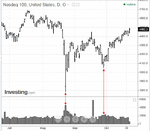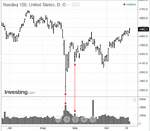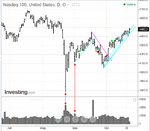Gring0
Well-known member
- Messages
- 264
- Likes
- 128
Even before the open today, price had shown to reverse around 1415. This was the first hint that there was a chance of a TR in the mix (or it already was in TR). Notice also the tightness of the range, as opposed to DL really getting breached with conviction. Price barely crossed the line and then went back up. So for me a potential TR and weak break of DL caused caution. This doesn't mean I wasn't at least still alert. Thing change fast in trading, but I wasn't watching when price failed at 1456 and didn't want to initiate a position in the middle of a TR.
I knew that price might continue down and I might miss the move, but I have come to be mostly at peace with these outcomes. Chasing leads to more trouble in my case as the entry is worse and any adverse move ends up in the red quickly. For me that triggers less than pleasant emotions and I avoid situations like these (mostly).
I also kind of glanced at S&P (ES) to see how it was doing. It's action was showing more strength as the price was higher than the previous (daily) swing high. NQ on the other hand was around the same region though not dropping. Both were pointing towards a bit of stability of demand and not of weakness.
So for SLA-AMT person, the fact that there was a TR before the regular market open was the ticket to try to enter at the extreme 1450 area if price failed. One essentially is then trading reversals. The width wasn't large enough of this TR for me to try it. Faster traders (those with smaller intervals) could have exploited it with reasonable risk control.
Gringo
I knew that price might continue down and I might miss the move, but I have come to be mostly at peace with these outcomes. Chasing leads to more trouble in my case as the entry is worse and any adverse move ends up in the red quickly. For me that triggers less than pleasant emotions and I avoid situations like these (mostly).
I also kind of glanced at S&P (ES) to see how it was doing. It's action was showing more strength as the price was higher than the previous (daily) swing high. NQ on the other hand was around the same region though not dropping. Both were pointing towards a bit of stability of demand and not of weakness.
So for SLA-AMT person, the fact that there was a TR before the regular market open was the ticket to try to enter at the extreme 1450 area if price failed. One essentially is then trading reversals. The width wasn't large enough of this TR for me to try it. Faster traders (those with smaller intervals) could have exploited it with reasonable risk control.
Gringo




